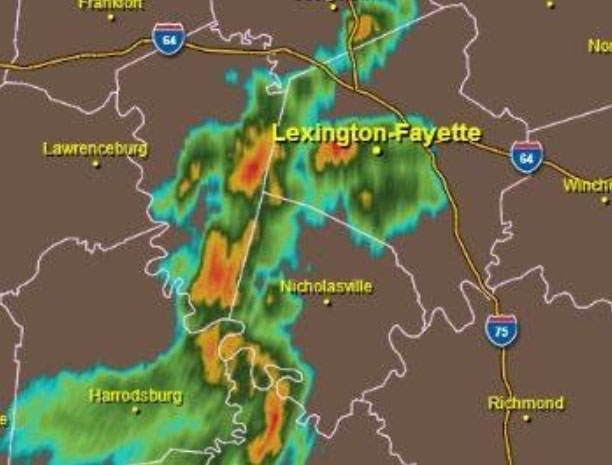Thunderstorms are most common in the spring and summer months, though Fayette County can see them at any time of the year. While all thunderstorms are dangerous because of the lightning they produce, severe thunderstorms deserve particular caution because of the potential for injury and property damage. Remember that heavy rain and flooding can come from severe storms that aren’t thunderstorms.
Remember:
Severe Thunderstorm Watch: There is a potential for thunderstorms which may produce large hail or damaging winds.
Severe Thunderstorm Warning: A severe thunderstorm has been sighted or indicated by weather radar. There is imminent danger to life and property. Take shelter immediately.
The National Weather Service classifies a thunderstorm as severe if it produces hail at least 1 inch in diameter or has wind gusts of at least 58 miles per hour. Every thunderstorm produces lightning. While lightning fatalities have decreased over the past 30 years, lightning continues to be one of the top three storm-related killers in the United States. On average in the U.S., lightning kills 51 people and injures hundreds more every year. Although most lightning victims survive, people struck by lightning often report a variety of long-term, debilitating symptoms.
Heavy rain from thunderstorms can cause flash flooding. High winds can damage homes and blow down trees and utility poles, causing widespread power outages. Other associated dangers of thunderstorms include tornadoes and hail.
Flash flooding is responsible for more fatalities – more than 140 annually – than any other thunderstorm-associated hazard. If flooding begins, abandon cars and climb to higher ground. Don’t try to drive to safety. Most flash flood deaths occur in automobiles.
The best defense against thunderstorms is to stay inside a sturdy building or shelter that can protect you from deadly lightning, large hail, damaging winds, flooding rain, and tornadoes. Fortunately, thunderstorms typically do not last very long and will most often pass by your location in less than one hour.
Once in a shelter, stay away from windows and avoid electrical equipment and plumbing. Remember to bring pets inside. If there is time, secure loose objects outside as these objects often become dangerous flying debris in high winds. Postpone outdoor activities until the storms have passed.
If caught outside, take shelter in a sturdy enclosed building or hard top automobile immediately. Avoid open spaces, isolated objects, high ground and metallic objects.
Get out of boats and away from bodies of water. Remember, if you can hear thunder, you are close enough to the storm to be struck by lightning.
Before a Thunderstorm
Check the weather forecast frequently if thunderstorms are likely. You can listen to radio, watch television, check weather related websites, or download an app for your smartphone. You can also listen to a NOAA All-Hazards Weather Radio for the latest forecast information and weather conditions. If you’re always “on the go” consider keeping a portable battery-powered NOAA weather radio in your pocketbook, briefcase, backpack or in your car.
During a Thunderstorm
Get to a safe place as soon as possible. This means a car or truck with a metal body or a shelter, home, or business that is strongly constructed. Stay away from windows and doors. Do not go out on porches. Do not use corded phones. Stay away from plumbing fixtures.
If you are outside and cannot reach a safe building, avoid high ground; water; tall, isolated trees; and metal objects such as fences or bleachers. Picnic shelters, dugouts and sheds are not safe.
Avoid contact with electrical equipment. Unplug televisions, computers and other valuable electrical equipment, if possible. Lightning can cause power surges through electric, telephone, and cable lines which can severely damage electrical equipment.
After the Thunderstorm
Check your home or office for damage. Be careful when checking electrical devices.
Never drive through a flooded roadway. Turn around, don’t drown!
Stay away from storm-damaged areas to keep from putting yourself at risk from the effects of severe thunderstorms.
Continue to listen to a NOAA Weather Radio or to local radio and television stations for updated information or instructions, as access to roads or some parts of the community may be blocked.
Help people who may require special assistance, such as infants, children and the elderly or those with access or functional needs.
Stay away from downed power lines and report them immediately.
Watch your animals closely. Keep them under your direct control.
Learn More
For more tips on thunderstorm preparedness, check out FEMA’s “Before a Thunderstorm” page.
For more tips on what to do during a severe thunderstorm, visit Ready.gov’s thunderstorm and lightning page.
As you might expect, the National Weather Service has some excellent resources on severe thunderstorms, including this Severe Weather 101 educational page and the National Severe Storms Laboratory’s site.
See the American Red Cross’ thunderstorm preparedness page for more tips on preparing for severe thunderstorms and dealing with their aftermath.


